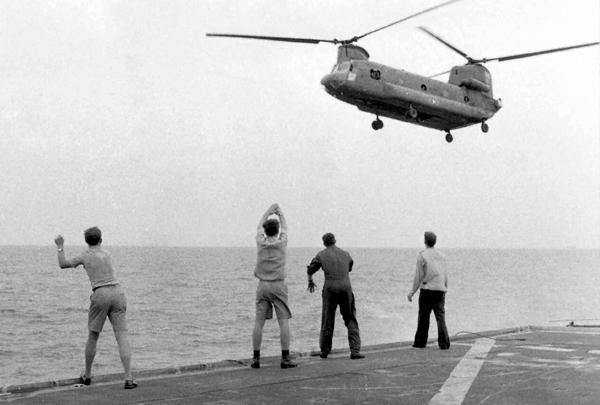The first-person accounts in Last Days in Vietnam put the audience into a gripping you-are-there Saigon in April 1975, when the United States ingloriously exited from 20 years of involvement while the whole world was watching. The infamous images of desperate South Vietnamese loyalists lined up by the American Embassy and grabbing for helicopters on a nearby roof turn out to be only part of the hasty retreat, in the extent of the human disaster and the heroic initiatives by individuals who put action over policies to save lives. Whenever the film sticks with those with no political investment, their personal testimonies are quite moving.
The contrast is set from the opening when the narrator introduces people who were there “facing a terrible moral dilemma: Who goes? Who gets left behind?” In the first example, a captain of the embassy guard proudly relates his unauthorized “borrowing” of an Army truck to pick up a close colleague, a South Vietnamese colonel, and his family and sneaking them onto one of the last cargo planes flying out.
The documentary dutifully goes back two years earlier for context familiar from “The War in Vietnam” episode of the Tom Hanks produced The Sixties series on CNN this summer, or PBS’s Vietnam: A Television History (1983), based on Stanley Karnow’s book. Emphasis here is put on the impact of the Watergate scandal pushing Richard Nixon out of the presidency, which “overnight everything changed” as the North Vietnamese aggressively pressed south. (The animated maps are helpful.)
After the billions spent, Congress refused more funds, causing the South Vietnamese army to run out of equipment and supplies. Former Secretary of State Henry Kissinger (with no Fog of War introspection) is unchallenged when he lists as a priority “the honor of the United States” just behind “saving people as human beings.” Former press secretary Ron Nessen clucks that the war situation that spring drove President Ford to utter the closest to profanity he’d ever heard him say.
Things were far worse in Saigon, seen in lots of footage of deserting South Vietnamese soldiers and panicking civilians on the run racing to the airport. Insightfully, director Rory Kennedy hones in on the weak link between this reality and Washington. The patrician U.S. Ambassador Graham Martin was still insisting to reporters in early April that there had been “no collapse,” as he had been advised by the CIA. Aides and colleagues mull differing perspectives on his almost delusional lack of evacuation planning in case the airport was attacked, which it was on April 29. (Instead, the guards were instructed to spend precious time burning “bags and bags” of Treasury Department dollars.)
After Kissinger convinced President Ford to “pull the plug,” the embassy staff recall the ambassador’s humane turnaround at this last possible moment when he finally tried to help the huge crowds filling the compound, including ordering trees cut to make more room and ease copter access. Marine guards, pilots, and Vietnamese recount hour by hour what was happening in getting copters into and out of the compound, with long lines incongruously wrapped around the swimming pool. The fates of those left behind are also poignantly revealed (justifying the panic of those thousands who had worked with the Americans). Not mentioned is the patronizingly colonial-tinged Operation Babylift that hastily shipped young orphans out of the country, resulting in a terrible plane crash.
Richard Armitage (much later the deputy secretary of state under President George Bush and a central figure in the Valerie Plame Wilson affair) was then a Special Forces advisor who discovered what was left of the South Vietnamese navy, a ragtag refugee armada overflowing with crew members’ families lurching out to sea for U.S. Navy protection. It was off the coast in the South China Sea where those boats and the last-resort copters were headed, to the USS Kirk aircraft carrier. The accounts by the pilots and the ship’s crew are enthralling. They chose to work around the clock to make up for the shameful lack of official planning to care for distraught allies, including pushing copters off the deck to make room for others to land.
Though the Cold War paranoid imagery of the Communist North Vietnamese is too readily accepted, the lessons not learned by the American military and diplomats in how to protect local supporters haunt the film, and have already been tragically repeated in Afghanistan in The Fixer: The Taking of Ajmal Naqshbandi (2009) and in Iraq, The List (2012). While this documentary was made for PBS’s American Experience series, the usefulness for seeing it in a theater is the discussions you’ll want to have afterwards about history and responsibility.







Leave A Comment